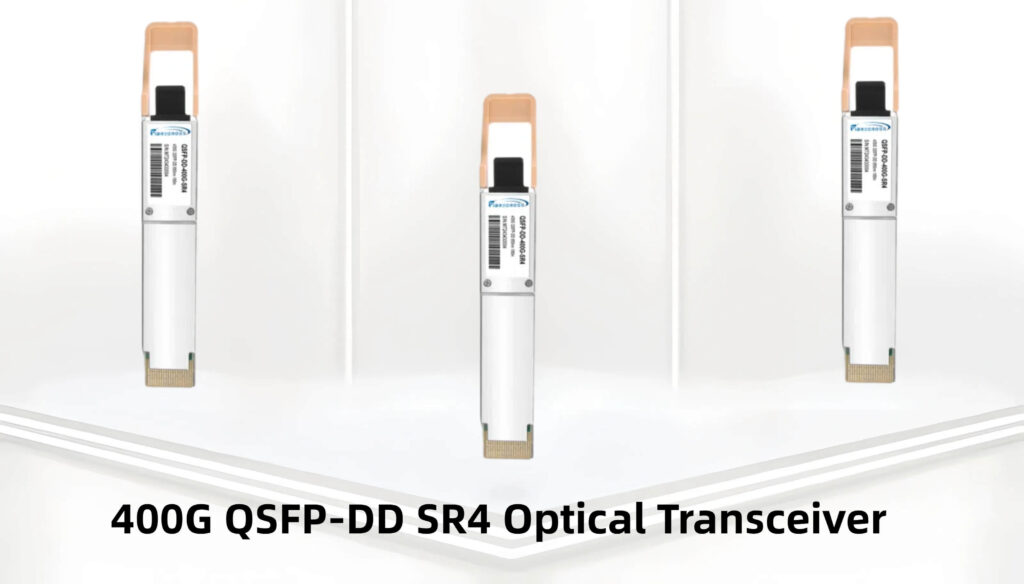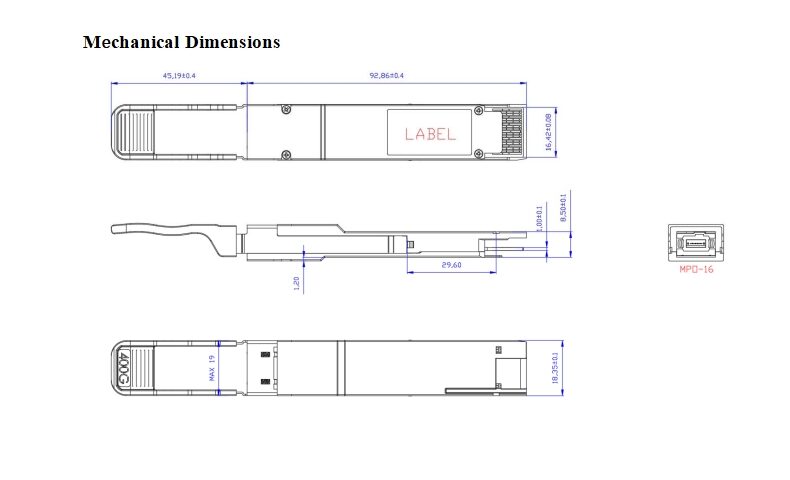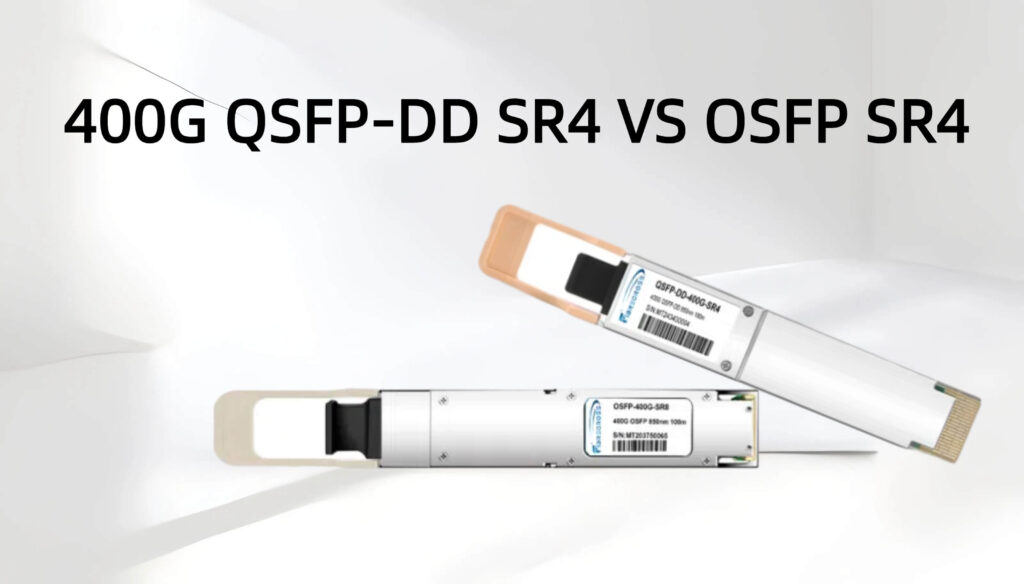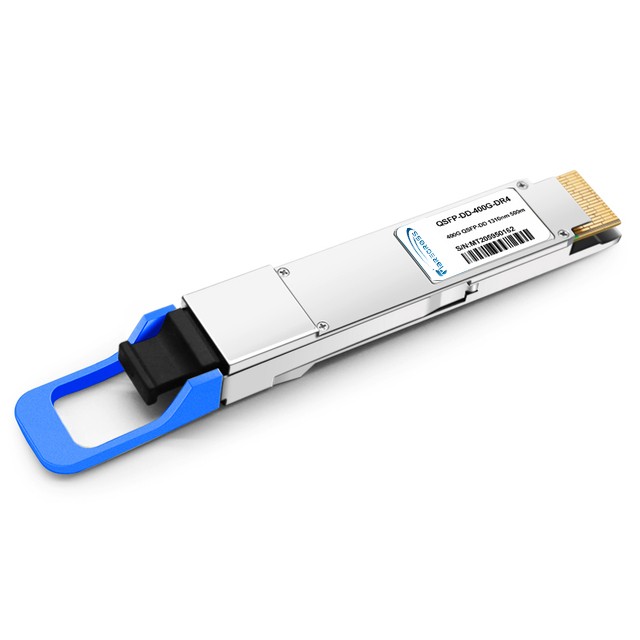What You Need to Know About 400G QSFP-DD SR4 Optical Transceiver?
As data traffic explodes due to cloud computing, AI workloads, and hyperscale architectures, upgrading to 400G Ethernet has become essential for modern data centers. Among the key enablers of this high-speed transition is the 400G QSFP-DD SR4 optical transceiver, a short-reach optical module optimized for multimode fiber connections. This article explains what 400G QSFP-DD SR4 is, how it works, and how it fits into the evolving cabling infrastructure of data centers.
What is a 400G QSFP-DD SR4 Optical Transceiver?
The 400G QSFP-DD SR4 (Quad Small Form-Factor Pluggable Double Density, Short Reach 4-lane) is an optical transceiver module compliant with the IEEE 802.3cd standard. It transmits data at 400 Gbps over multimode fiber (MMF) using four parallel optical lanes, each operating at 100 Gbps via PAM4 modulation.
Key Features:
Form Factor: QSFP-DD (compact, high-density)
Data Rate: 400 Gbps (8×50 Gbps electrical / 4×100 Gbps optical)
Wavelength: 850 nm
Reach: Up to 100 meters over OM4 fiber
Interface: MPO-12 connector
Modulation: PAM4 (Pulse Amplitude Modulation 4-level)
The 400G QSFP-DD SR4 module is widely used in leaf-spine data center architectures, switch uplinks, and short-distance high-speed interconnects.
Why Choose QSFP-DD for 400G Deployments?
QSFP-DD is the dominant form factor for 400G deployments due to its backward compatibility, space efficiency, and cost-effectiveness. Here’s why it matters:
1. Compact Size with High Port Density
QSFP-DD enables 36×400G ports per 1U switch, delivering up to 14.4 Tbps per rack unit—ideal for space-constrained data centers.
2. Backward Compatibility
Supports legacy QSFP+ (40G) and QSFP28 (100G) modules, enabling gradual upgrades without full infrastructure replacement.
3. Industry Standardization
The QSFP-DD MSA and IEEE standards ensure multi-vendor interoperability, supply chain flexibility, and long-term scalability.
400G SR4 Optical Performance and Fiber Types
The 400GBASE-SR4 standard defines a short-reach 400G optical link over OM3, OM4, or OM5 multimode fiber using parallel optics and an MPO-12 connector.
| Fiber Type | Maximum Distance |
|---|---|
| OM3 | 70 meters |
| OM4 | 100 meters |
| OM5 | 100+ meters (no SR4-specific advantage) |
Each optical transceiver uses 8 of 12 fibers (4 Tx, 4 Rx), leaving 4 unused. Proper polarity and low-loss connectors are critical for maintaining signal integrity.
Understanding PAM4 Modulation in 400G Optical Transceivers
To achieve 400G data rates within QSFP-DD’s compact size and power envelope, PAM4 modulation is used on both electrical and optical interfaces.
What is PAM4?
PAM4 (Pulse Amplitude Modulation 4-level) encodes 2 bits per symbol, effectively doubling bandwidth over traditional NRZ (non-return-to-zero).
Benefits of PAM4 in 400G:
Enables 50 Gbps per lane over copper and 100 Gbps per optical lane.
Reduces lane count, simplifying cabling.
Paired with DSP and FEC for signal clarity and error correction.
Challenges:
Requires advanced DSP (digital signal processing)
Higher sensitivity to noise, demanding clean, short optical paths (ideal for MMF SR4 use)
400G QSFP-DD SR4 vs OSFP SR4: Which to Choose?
Both QSFP-DD and OSFP transceivers support 400G SR4 optics, but differ in form factor and application suitability:
| Feature | OSFP SR4 | QSFP-DD SR4 |
|---|---|---|
| Form Factor | Larger (107.8 × 22.58 × 13.0 mm) | Smaller (89.4 × 18.35 × 8.5 mm) |
| Thermal Capacity | Higher (12–15 W typical) | Moderate (7–12 W typical) |
| Cooling Design | Integrated large heatsink (Type 2 finned version) | Passive or smaller heatsink |
| Power Consumption | Higher headroom for power-intensive modules | Limited by size constraints |
| Backward Compatibility | ❌ Not natively compatible with QSFP+/QSFP28 | ✅ Compatible with QSFP+/QSFP28 |
| Port Density per 1U | Up to 36 ports (14.4 Tbps) | Up to 36 ports (14.4 Tbps) |
| Interoperability (Optical) | ✅ Interoperable over 400GBASE-SR4 (same fiber, optic spec) | ✅ Interoperable over 400GBASE-SR4 |
| Mechanical Interchangeability | ❌ Different cage/interface required | ❌ Different cage/interface required |
| Cable Type | MPO-12 MMF (OM4/OM5, 850 nm VCSEL) | MPO-12 MMF (OM4/OM5, 850 nm VCSEL) |
| Application Readiness | Optimized for future 800G (8×100G) deployments | Common in current 400G networks; limited 800G support |
| Ecosystem Maturity | Growing adoption, especially for high-power 800G optics | Broad vendor support and mature deployment base |
QSFP-DD SR4 is ideal for high-density, short-reach links where power consumption and backward compatibility are key. OSFP SR4 may be preferred in environments with higher power budgets.
Applications of 400G QSFP-DD SR4 Transceivers
Leaf-Spine Interconnects
Connect leaf switches to spine switches with up to 100 m of OM4 cabling.ToR (Top-of-Rack) Switching
Enable high-bandwidth uplinks from ToR switches to aggregation layers.Enterprise Campus and Cloud Data Centers
Support latency-sensitive, bandwidth-intensive applications like AI training, virtualization, and real-time analytics.Server-to-Switch and Switch-to-Switch Connections
Ideal for short-distance, high-throughput connections between high-performance network nodes.
Summary: Why Deploy 400G QSFP-DD SR4?
The 400G QSFP-DD SR4 transceiver offers a reliable, scalable, and efficient solution for high-density 400G short-reach deployments:
✅ IEEE 802.3cd compliant
✅ Supports up to 100 m over OM4 fiber
✅ MPO-12 connector with 8 active lanes
✅ QSFP-DD backward compatible
✅ Ideal for high-performance, short-reach data center applications
For hyperscale, cloud, and AI/ML infrastructure, 400G QSFP-DD SR4 helps achieve faster speeds, more bandwidth, and greater efficiency without overhauling your existing cabling.
Looking to upgrade your data center with reliable 400G connectivity?
Explore Fibrecross’s full range of 400G QSFP-DD optical transceivers and MPO multimode cabling—engineered for performance, reliability, and seamless integration.









